National Palace Museum's Digital Exhibition Showcases Artifacts: GCIT Students Seek New Inspirations from National Treasures
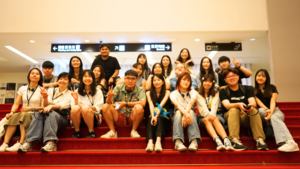
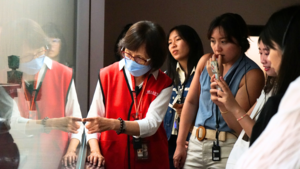
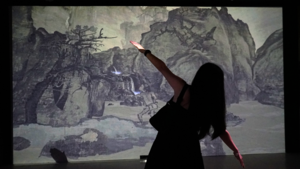
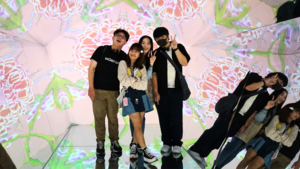
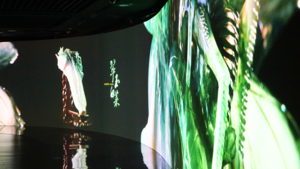
Date :
2024-06-20
Department :
Master’s Program in Global Communication and Innovation Technology
【Article by Master’s Program in Global Communication and Innovation Technology】
The National Palace Museum recently unveiled its new media art exhibition, "Evoking Aura: Evoking Visionary Insights," as part of its immersive digital exhibition series. Seizing this rare opportunity, students from the Master's Program in Global Communication and Innovation Technology (GCIT) at National Chengchi University, led by a museum guide, embarked on an in-depth cultural exploration on June 19. The visit featured explanations of ancient bronze artifacts and an innovative digital interactive exhibition that combined projections, interactive technology, and immersive theater to reimagine classic treasures such as the "Jadeite Cabbage," "Meat-shaped Stone," and "Travelers Among Mountains and Streams," showcasing the novel artistic charm granted by digital technology.
During the visit, the museum guide led the students to the "Rituals Cast in Brilliance: Masterpieces of Bronzes in the Museum Collection" section, offering a comprehensive introduction to the development of bronze casting techniques during the Shang and Zhou dynasties. The students closely observed artifacts like the Pan water vessel of San, the Mao Gong Ding, and the late Shang food vessel "Na Sun Zuo Zu Yi Ding." The guide explained the intricate carvings and symbolic meanings of the animals engraved on these bronze pieces, engaging the students in interactive guessing and thinking exercises to learn the historical stories and social contexts behind these ancient artifacts.
The mid-Warring States period wine vessel, "Zun wine vessel in the shape of an animal with metal wire and turquoise inlay," resembling a modern Malayan tapir, was particularly popular among the students, who eagerly took photos with it. Another artifact that captivated the students was the "Hu wine vessel of Song" from the Zhou dynasty, which records the ceremony in which the King of Zhou conferred titles of nobility upon Song. Mei Hua Te, a student from Thailand, was impressed by the detailed inscription on the vessel, which meticulously documents the various stages of the ritual, likening it to a historical book filled with rich stories.
In addition to introducing ancient artifacts, the digital interactive exhibitions "The Epitome of Aesthetics" and "Evoking Aura" used high-resolution screen projections and 3D interactive devices to bring the students closer to the artifacts. They could examine the intricate textures and details of the "Meat-shaped Stone" that are usually inaccessible. These digital files and 3D models allowed the students to explore the artifacts up close, experiencing the profound emotions that ancient people felt when observing these treasures.
The exhibition also featured 8K documentary films and high-resolution images of classic artifacts from the museum's collection, enhancing the viewer’s sensory experience through digital technology. The "Budding Early Spring" piece was particularly eye-catching, with its dynamic images bringing the landscape to life, allowing viewers to immerse themselves in the details of the painting. The seamless projection technology perfectly recreated the Ming and Qing masterpiece "Up the River During the Qingming," enabling viewers to experience the vibrant scenes of daily life from centuries ago. Student Ping Li Wu noted that these digital interpretations made the historical significance of the artifacts more vivid and understandable, helping audiences better understand their cultural value.
This visit deepened the GCIT students' understanding of ancient Chinese culture and art and allowed them to experience how digital technology can breathe new life into historical artifacts. Through diverse and innovative exhibition forms, the National Palace Museum is making these precious historical artifacts more accessible and understandable, contributing to preserving and promoting classical culture in a modern context.
The National Palace Museum recently unveiled its new media art exhibition, "Evoking Aura: Evoking Visionary Insights," as part of its immersive digital exhibition series. Seizing this rare opportunity, students from the Master's Program in Global Communication and Innovation Technology (GCIT) at National Chengchi University, led by a museum guide, embarked on an in-depth cultural exploration on June 19. The visit featured explanations of ancient bronze artifacts and an innovative digital interactive exhibition that combined projections, interactive technology, and immersive theater to reimagine classic treasures such as the "Jadeite Cabbage," "Meat-shaped Stone," and "Travelers Among Mountains and Streams," showcasing the novel artistic charm granted by digital technology.
During the visit, the museum guide led the students to the "Rituals Cast in Brilliance: Masterpieces of Bronzes in the Museum Collection" section, offering a comprehensive introduction to the development of bronze casting techniques during the Shang and Zhou dynasties. The students closely observed artifacts like the Pan water vessel of San, the Mao Gong Ding, and the late Shang food vessel "Na Sun Zuo Zu Yi Ding." The guide explained the intricate carvings and symbolic meanings of the animals engraved on these bronze pieces, engaging the students in interactive guessing and thinking exercises to learn the historical stories and social contexts behind these ancient artifacts.
The mid-Warring States period wine vessel, "Zun wine vessel in the shape of an animal with metal wire and turquoise inlay," resembling a modern Malayan tapir, was particularly popular among the students, who eagerly took photos with it. Another artifact that captivated the students was the "Hu wine vessel of Song" from the Zhou dynasty, which records the ceremony in which the King of Zhou conferred titles of nobility upon Song. Mei Hua Te, a student from Thailand, was impressed by the detailed inscription on the vessel, which meticulously documents the various stages of the ritual, likening it to a historical book filled with rich stories.
In addition to introducing ancient artifacts, the digital interactive exhibitions "The Epitome of Aesthetics" and "Evoking Aura" used high-resolution screen projections and 3D interactive devices to bring the students closer to the artifacts. They could examine the intricate textures and details of the "Meat-shaped Stone" that are usually inaccessible. These digital files and 3D models allowed the students to explore the artifacts up close, experiencing the profound emotions that ancient people felt when observing these treasures.
The exhibition also featured 8K documentary films and high-resolution images of classic artifacts from the museum's collection, enhancing the viewer’s sensory experience through digital technology. The "Budding Early Spring" piece was particularly eye-catching, with its dynamic images bringing the landscape to life, allowing viewers to immerse themselves in the details of the painting. The seamless projection technology perfectly recreated the Ming and Qing masterpiece "Up the River During the Qingming," enabling viewers to experience the vibrant scenes of daily life from centuries ago. Student Ping Li Wu noted that these digital interpretations made the historical significance of the artifacts more vivid and understandable, helping audiences better understand their cultural value.
This visit deepened the GCIT students' understanding of ancient Chinese culture and art and allowed them to experience how digital technology can breathe new life into historical artifacts. Through diverse and innovative exhibition forms, the National Palace Museum is making these precious historical artifacts more accessible and understandable, contributing to preserving and promoting classical culture in a modern context.
